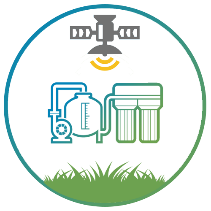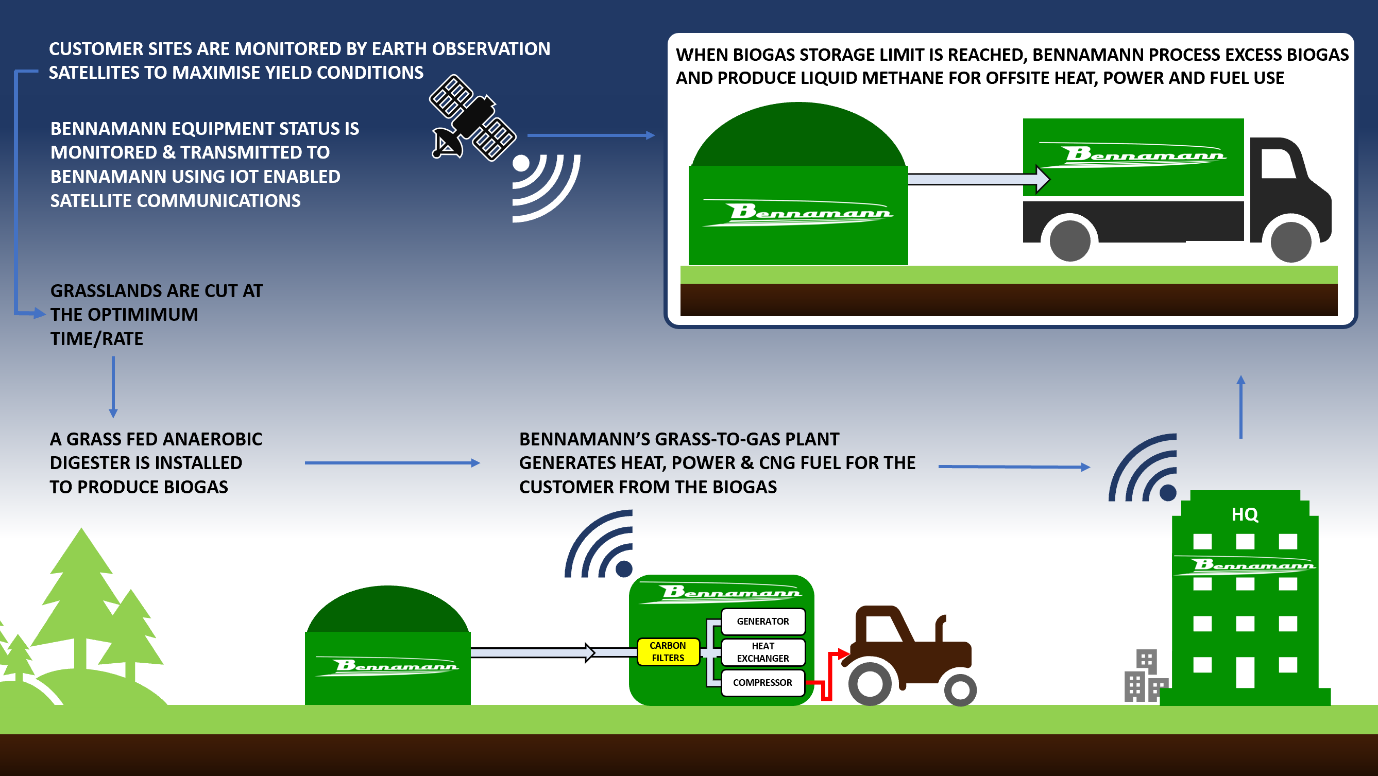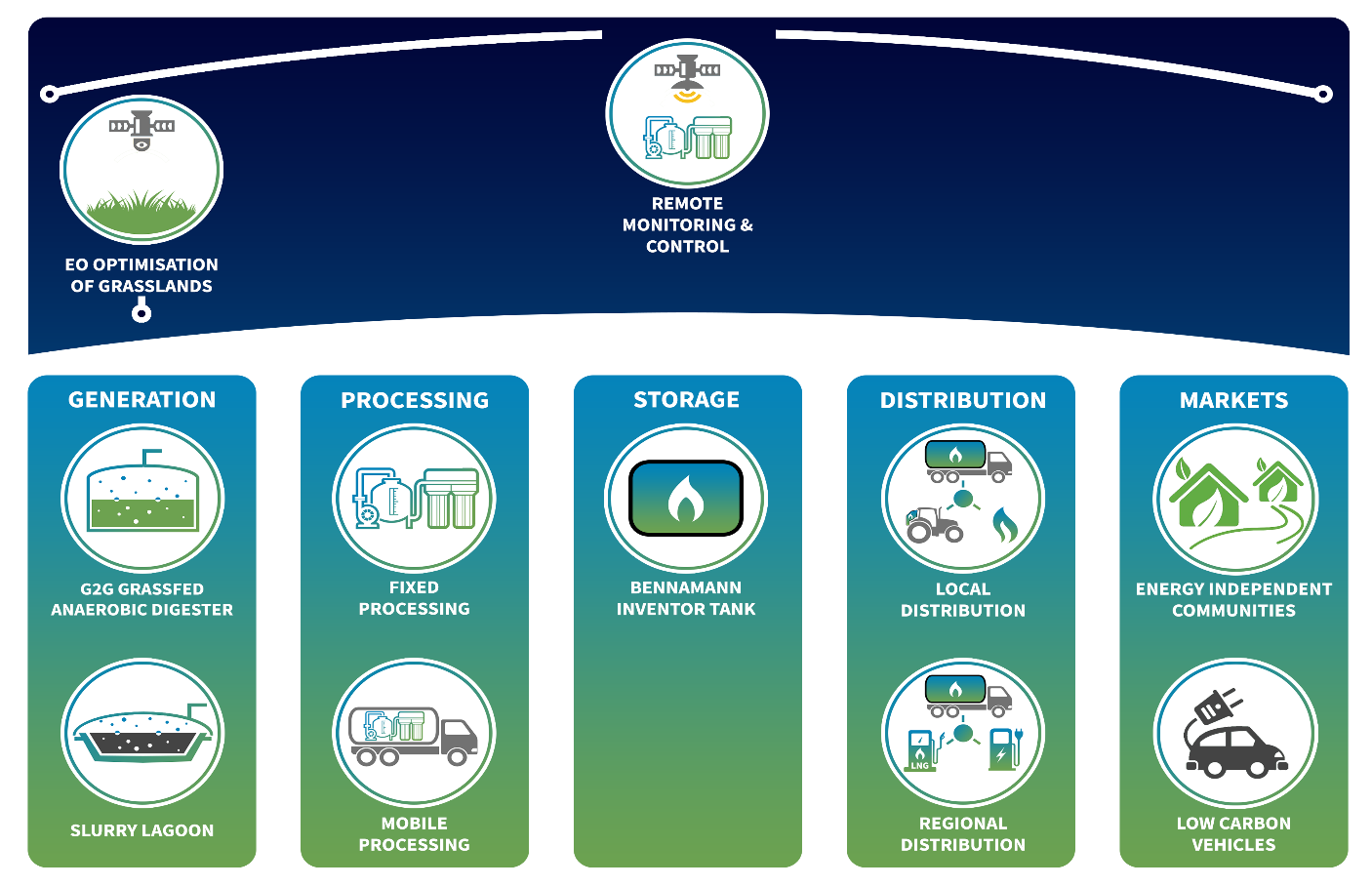
Objectives of the service
All organic matter (animal waste, grass clippings, leaves) produces methane as it decays. If it is not captured, it is referred to as fugitive methane, which is emitted into the atmosphere and is 86 times more harmful than CO2 as a greenhouse gas over ten years.
Bennamann’s goal is to capture fugitive methane that is produced by customers during their business-as-usual operations, and generate additional value for those organisations by capturing, processing, storing and distributing their biomethane. Bennamann’s key differentiator its focus on micro-scale producers of biomethane, who are currently under-served, and the solution covers the entire value chain.

Bennamann’s early adopter market is agriculture, but the ultimate primary market is grasslands owners/grasslands management companies. Small farms, footballs, golf clubs, schools etc. produce fugitive methane in their business as usual operations. Bennamann has developed a suite of solutions across the value chain that allow low-cost capture and distribution of fugitive methane.
Users and their needs
Agricultural Sector: Dairy Farmers (multi-farm owners <150 head, medium farmers >250 head)
- Maximise profitability of the farm
- Manage energy requirements of the farm
- Manage farm-generated waste
- Comply with environmental regulations
Multi-farm Owners
Local Authorities (LA), Trusts and Heritage Organisations own tenant farms and are responsible for their infrastructure including the slurry pits used for farm animal waste storage. Most will need upgrading to meet Clean Air Directive (CAD) requirements but no additional funding is being made available by the UK Government to support the transition. As a consequence, unfortunately, there is an ongoing trend for farms approaching the end of their tenancy period to be sold.
Medium Farmers
The number of dairy farms has reduced dramatically in the UK over the past 30 years, due to the challenge of generating sustainable profit margins. Farmers are struggling to compete with ever-higher fuel and fertiliser costs as well as increased requirements for compliance with a plethora of environmental pollution regulations and Greenhouse Gas (GHG) emissions reduction legislation. Increasing public awareness of the intensive environmental and animal husbandry issues of traditional farming practices combined with a reliance on fossil fuels, limits a farmer’s ability to adapt their business model without becoming uncompetitive.
Heavy Goods Vehicles Owners:
- Deliver maximum operational benefits through choice of vehicle
- Lower carbon emissions of vehicle as much as possible without damaging profitability of the business
- Comply with emissions regulations (e.g. Euro 6 emissions standards)
Heavy-duty vehicles manufacturers are under increasing pressure to reduce emissions; by 2030 trucks/buses/heavy-duty vehicles will need to have reduced their emissions by 30%. Introduction of clean air zones makes last-mile delivery a challenge for logistics companies, which has a negative impact on profit margins, as the last mile is often the most profitable element of the business model. Similarly, the agricultural and heavy-duty vehicle sectors need to find ways to cut their emissions, while still being able to operate their vehicles via comparable duty cycles to current diesel vehicles. OEMs have developed and tested electric and hydrogen vehicles, but they are either prohibitively expensive or incapable of delivery comparable duty cycles.
Landowners:
- Maximise profitability of the business
- Manage property energy requirements
- Manage grassland-generated waste
- Comply with environmental regulations (waste disposal)
Biomethane customers: using biomethane gas as a replacement for natural gas/gas-powered vehicle fuel, liquified biomethane as a replacement for diesel/petrol for heavy duty vehicles
- Low carbon energy (as Bennamann captures fugitive methane that would emitted to earth’s atmosphere if not captured, it is a better than zero carbon source of energy)
UK is the initial target market; the solution will be sold globally over time.
Service/ system concept

The solution supplied to customer includes a product and services bundle. Generation, processing and storage hardware is supplied to the customer in order to generate, process and store biomethane. This allows our customers to use/sell the biomethane they capture as a flexible source of energy/source of additional revenue. Services cover installation, control and maintenance of the hardware, as well as tools to help maximise gas yields and a distribution channel for customers wishing to sell excess biomethane.
Internet of Things (IoT) enabled sensors are used to gauge how much grass has been cut/animal waste added to the anaerobic digester, how much raw biogas has been generated, how much gas is used onsite by the customer, how much raw biogas is processed into sellable biomethane, how much biomethane is in the storage unit, when it needs to be collected for distribution and sale. The IoT sensors create a digital twin of the system that ensures it is operationally efficient and provides Bennamann with alerts that allow timely maintenance and servicing of the hardware.

Space Added Value
The Earth Observation Grasslands Optimisation tool will be used for prospecting by calculating the size of available grassland areas along with the likely biomethane return on investment. The tool will be used to optimise cutting regimes to maximise gas yield. A combination of optical remote sensing data (proximal hyperspectral and Sentinel 2) with a radiative transfer model is used to estimate Leaf Area Index (LAI) and biomass.
Satellite communication is used to gather IoT data in rural environments where terrestrial networks are unavailable.
Satellite positioning technology will be used to monitor the location of assets (mobile processing and distribution vehicles, storage assets, fixed processing hardware), to optimise operations in the case of mobile processing and distribution and to monitor fixed assets from a security perspective, as they are high-value assets.
Current Status
All hardware required to deliver the intended service has been developed to prototyp level and has been tested in operational environments.


Value chain partners to deliver the full service have been identified. A Premier League Football Club and two B2B customers in Cornwall have agreed to partner with Bennamann to build a demonstator on site that will demonstrate the IoT-enabled remote monitoring and control system as well as the EO grassland optimisation services.


